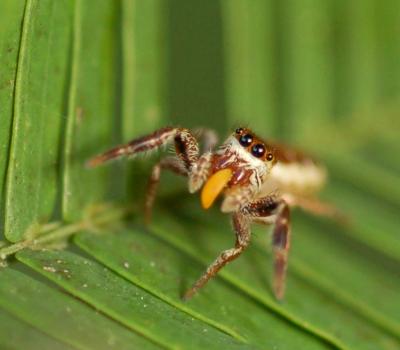The spiders' veggie option of choice is so-called Beltian bodies, specialized leaf-tip structures produced by acacia shrubs. The Beltian bodies normally serve as a food reward for ants that live in hollow spines of the acacia and act as the plants' "bodyguards."
The ant-acacia mutualism is one of the most celebrated and well-studied examples of coevolution in nature.

Adult female Bagheera kiplingi eats Beltian body harvested from ant-acacia Credit: R. L. Curry
"This is really the first spider known to specifically 'hunt' plants; it is also the first known to go after plants as a primary food source," said Christopher Meehan of Villanova University, who took notice of the spiders during a field course in Mexico. He notes that the spiders were independently observed in Costa Rica by study coauthor Eric Olson of Brandeis University.
In fact, Meehan added, B. kiplingi is the only spider known to consume solid, vegetative plant food at all. The spiders do occasionally prey on small invertebrates, but the authors confirmed through both field observations and chemical analyses of the spiders' tissue that these arachnids eat a primarily vegetarian diet.
"I've done the math several times, and even the most conservative estimates point to near-total vegetarianism," Meehan said. Almost all of the prey that the spiders do eat are acacia-defending ant larvae.
Before now, "herbivory" in spiders meant only that a spider infrequently consumed a bit of either nectar or pollen, Meehan continued. Pollen-feeding has only been well documented in a single orb-weaving species—and only in the juveniles, who incidentally swallow pollen and anything else that might get caught in their webs in the process of recycling their silk. Nectar feeding is probably fairly common among spiders that actively hunt instead of building webs, but this is only a rare supplement, and certainly a distant second to carnivory in terms of their overall diet.
"Spiders aren't really thought to be capable of eating solid food at all," Meehan said. Spiders digest their prey externally, he explained, and any matter bigger than about one micrometer gets filtered out of the vital juices in the spider's pharynx. Beltian bodies, however, are 80 percent structural fiber, and quite large by spider standards. "The acacia spiders consume these nutrient-enriched—but not particularly nutrient-rich—'vegetables' completely, often in less than five minutes."
How do the spiders get around the ants that are supposed to be guarding the acacias and gobbling up the Beltian bodies themselves?
First, Meehan said, the spiders have what might be thought of as "sheer wit." "Jumping spiders in general possess incredibly advanced sensory-cognitive skills and eight-legged agility, and Bagheera is no exception," he said. "Individuals employ diverse, situation-specific strategies to evade ants, and the ants simply cannot catch them."
The spiders also seem to build their webs in less attractive plant "real estate" and to actively defend their nests against ant invaders. Finally, Meehan added, the spiders might actually mimic the ants. Young spiders in particular look a lot like and seem to act like ants, one reason they have perhaps flown under scientists' radar for so long despite intensive study of the ants and acacias. Meehan suspects that the spiders wear the ants' chemical scent as well, a notion he is now investigating in more detail.
The researchers include Christopher J. Meehan, Villanova University, Villanova, PA, Eric J. Olson, Brandeis University, Waltham, MA; Matthew W. Reudink, Trent University, Peterborough, ON, Canada; T. Kurt Kyser, Queen's University, Kingston, ON, Canada; and Robert L. Curry, Villanova University, Villanova, PA.






Comments